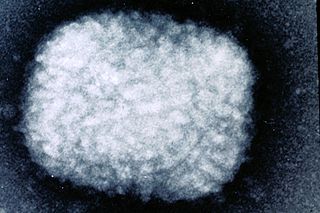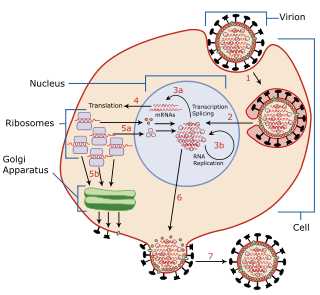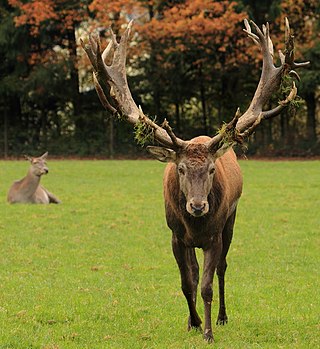
Poxviridae is a family of double-stranded DNA viruses. Vertebrates and arthropods serve as natural hosts. There are currently 83 species in this family, divided among 22 genera, which are divided into two subfamilies. Diseases associated with this family include smallpox.

Parapoxvirus is a genus of viruses, in the family Poxviridae, in the subfamily Chordopoxvirinae. Like all members of the family Poxviridae, they are oval, relatively large, double-stranded DNA viruses. Parapoxviruses have a unique spiral coat that distinguishes them from other poxviruses. Parapoxviruses infect vertebrates, including a wide selection of mammals, and humans.

Viral replication is the formation of biological viruses during the infection process in the target host cells. Viruses must first get into the cell before viral replication can occur. Through the generation of abundant copies of its genome and packaging these copies, the virus continues infecting new hosts. Replication between viruses is greatly varied and depends on the type of genes involved in them. Most DNA viruses assemble in the nucleus while most RNA viruses develop solely in cytoplasm.

Molluscum contagiosum virus (MCV) is a species of DNA poxvirus that causes the human skin infection molluscum contagiosum. Molluscum contagiosum affects about 200,000 people a year, about 1% of all diagnosed skin diseases. Diagnosis is based on the size and shape of the skin lesions and can be confirmed with a biopsy, as the virus cannot be routinely cultured. Molluscum contagiosum virus is the only species in the genus Molluscipoxvirus. MCV is a member of the subfamily Chordopoxvirinae of family Poxviridae. Other commonly known viruses that reside in the subfamily Chordopoxvirinae are variola virus and monkeypox virus.

Canarypox virus (CNPV) is an Avipoxvirus and etiologic agent of canarypox, a disease of wild and captive birds that can cause significant losses. Canarypox can enter human cells, but it cannot survive and multiply in human cells. There is a live viral vaccine available which may have beneficial properties against human cancer when used as a mammalian expression vector.. Furthermore, the Poximune C vaccine does offer direct protection against CNPV in susceptible birds.
Avipoxvirus is a genus of viruses within the family Poxviridae. Poxviridae is the family of viruses which cause the afflicted organism to have poxes as a symptom. Poxviruses have generally large genomes, and other such examples include smallpox and monkeypox. Members of the genus Avipoxvirus infect specifically birds. Avipoxviruses are unable to complete their replication cycle in non-avian species. Although it is comparably slow-spreading, Avipoxvirus is known to cause symptoms like pustules full of pus lining the skin and diphtheria-like symptoms. These diphtheria-like symptoms might include diphtheric necrotic membranes lining the mouth and the upper respiratory tract. Like other avian viruses, it can be transmitted through vectors mechanically such as through mosquitoes. There is no evidence that this virus can infect humans.
Yatapoxvirus is a genus of viruses, in the family Poxviridae, in the subfamily Chordopoxvirinae. Monkeys and baboons serve as natural hosts. There are two species in this genus. Diseases associated with this genus can cause histiocytomas, tumor-like masses of mononuclear cells.
Chordopoxvirinae is a subfamily of viruses in the family Poxviridae. Vertebrates and arthropods serve as natural hosts. Currently, 52 species are placed in this subfamily, divided among 18 genera. Diseases associated with this subfamily include smallpox.
Entomopoxvirinae is a subfamily of viruses, in the family Poxviridae. Insects, human, vertebrates, and arthropods serve as natural hosts. There are currently 31 species in this subfamily, divided among 4 genera with one species unassigned to a genus. Diseases associated with this subfamily include: impairment of motility and development.
Capripoxvirus is a genus of viruses in the subfamily Chordopoxvirinae and the family Poxviridae. Capripoxviruses are among the most serious of all animal poxviruses. All CaPV are notifiable diseases to the OIE. Sheep, goat, and cattle serve as natural hosts. These viruses cause negative economic consequences by damaging hides and wool and forcing the establishment of trade restrictions in response to an outbreak. The genus consists of three species: sheeppox virus (SPPV), goatpox virus (GTPV), and lumpy skin disease virus (LSDV). They share no serological relationship with camel pox, horse pox, or avian poxes. Capripoxviruses for sheeppox and goatpox infect only sheep and goat respectively. However, it is probable that North American relatives, the mountain goat and mountain sheep, may be susceptible to the strains but has not been experimentally proven. Lumpy skin disease virus affects primarily cattle, but studies have been shown that giraffes and impala are also susceptible to LSDV. Humans cannot be infected by Capripoxviruses.
Betaentomopoxvirus is a genus of viruses, in the family Poxviridae, in the subfamily Entomopoxvirinae. Lepidoptera and orthoptera insects serve as natural hosts. There are 16 species in this genus.
Cervidpoxvirus is a genus of viruses in the family Poxviridae in the subfamily Chordopoxvirinae. Deer serve as natural hosts. Only one species is in this genus: Mule deerpox virus.
Gammaentomopoxvirus is a genus of viruses, in the family Poxviridae, in the subfamily Entomopoxvirinae. Lepidoptera and orthoptera insects serve as natural hosts. There are six species in this genus.
Leporipoxvirus is a genus of viruses, in the family Poxviridae, in the subfamily Chordopoxvirinae. Lagomorphs and squirrels serve as natural hosts. There are four species in this genus. Diseases associated with this genus include: myxomatosis.
Suipoxvirus is a genus of viruses in the family Poxviridae and subfamily Chordopoxvirinae. Swine serve as natural hosts. There is only one species in this genus: Swinepox virus. Diseases associated with this genus include asymptomatic skin disease.
Crocodylidpoxvirus is a genus of viruses, in the family Poxviridae, in the subfamily Chordopoxvirinae. Crocodiles serve as natural hosts. There is only one species in this genus: Nile crocodilepox virus. Diseases associated with this genus include: nodular skin lesions in young animals. Symptoms vary from a nonfatal dermatitis to more severe disease characterized by ophthalmia, rhinitis resulting in asphyxia, and debilitating illness with stunting and high mortality.
Raccoonpox virus (RCN) is a double-stranded DNA virus and a member of the orthopoxviruses in the family Poxviridae and subfamily Chordopoxvirinae. Vertebrates are the natural host of Chordopoxvirinae subfamily viruses. More specifically, raccoons are the natural hosts of RCN. RCN was isolated in 1961 from the upper respiratory tissues of 2 raccoons in a group of 92 observably healthy raccoons trapped close to Aberdeen, Maryland.
A kinetic class, also known as a temporal class, is a grouping of genes in a viral genome that are expressed at the same time during the viral replication cycle. Five of the human DNA viral families have multiple kinetic classes: Poxviridae, Herpesviridae, Adenoviridae, Papillomaviridae, and Polyomaviridae. All of the genes in a particular kinetic class are activated by the same mechanism: either by the process of the virus entering the cell and uncoating, or by the products of an earlier kinetic class in what is known as a transcriptional cascade. Generally speaking, earlier kinetic classes code for enzymes that direct the viral replication process, and later kinetic classes code for structural proteins to be packaged into virions

Red deerpox virus (RDPV) is a species of virus in the genus Parapoxvirus. It has been reported in deer in New Zealand, and in wild ruminants in Italy.

Avian metaavulavirus 2, formerly Avian paramyxovirus 2, is a species of virus belonging to the family Paramyxoviridae and genus Metaavulavirus. The virus is a negative strand RNA virus containing a monopartite genome. Avian metaavulavirus 2 is one of nine species belonging to the genus Metaavulavirus. The most common serotype of Avulavirinae is serotype 1, the cause of Newcastle disease (ND). Avian metaavulavirus 2 has been known to cause disease, specifically mild respiratory infections in domestic poultry, including turkeys and chickens, and has many economic effects on egg production and poultry industries. The virus was first isolated from a strain in Yucaipa, California in 1956. Since then, other isolates of the virus have been isolated worldwide.






